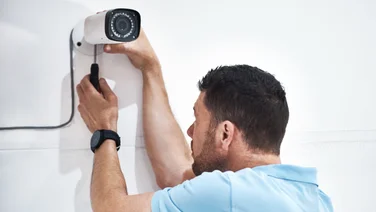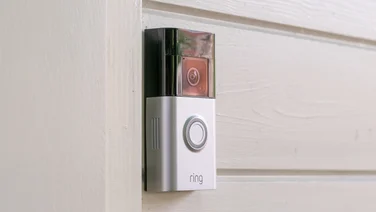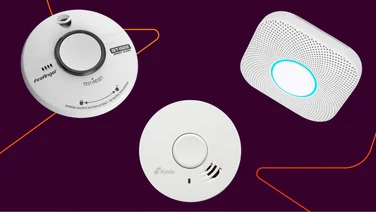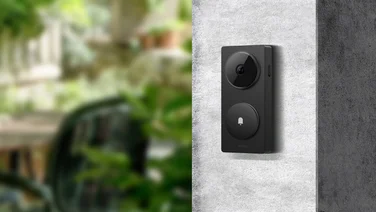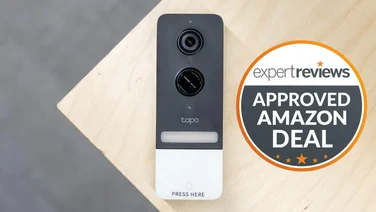To help us provide you with free impartial advice, we may earn a commission if you buy through links on our site. Learn more
- Black Friday 2025 deals:
- Best video doorbell: At a glance
- The best video doorbells you can buy in 2025
- 1. TP-Link Tapo D235: Best video doorbell overall
- 2. Eufy Video Doorbell E340 (with chime): Best dual-camera video doorbell
- 3. Tapo D210: Best budget video doorbell
- 4. Blink Video Doorbell (2nd gen): Best ultra-cheap video doorbell
- 5. Doro Hemma: Best simple video doorbell for the elderly and vulnerable
- 6. Nest Doorbell (battery): Best Google Nest video doorbell
- 7. Ring Battery Video Doorbell (2024): Best budget Ring doorbell
- 8. Ring Video Doorbell Plus: Best Ring video doorbell
- 9. Aqara Video Doorbell G4: Best video doorbell for iPhone owners
- How to choose the best video doorbell for you
- We’ve been testing video doorbells since the first Ring doorbells were launched, and we subject each and every one to the same tough set of tests
- Every doorbell is judged against five key criteria – ease of use and setup, features, image and audio quality and responsiveness – and we make both subjective judgements and take objective measurements to back up our conclusions
- Our favourite video doorbell overall is the Tapo D235. It delivers against all our evaluation criteria, has impressive battery life, comes with a chime in the box and you can run it without having to pay a monthly subscription
- Our second pick, if you don’t mind spending a bit more, is the Eufy E340, which uses two cameras. One points out horizontally; the other points down, so you can see if a courier has left a package on the doorstep

The best video doorbell you can buy isn’t a name most people would recognise: it’s the Tapo D235, a doorbell that trounces the best doorbells Ring has to offer for value, and matches them for features image quality and usability. Most importantly, it’s a doorbell you can use without restriction or having to pay a monthly fee.
It isn’t the most fully featured doorbell around, though, so if you want something more advanced, take a look at some of our other recommendations below. From dual camera doorbells to products designed with elderly, more vulnerable users in mind, we have an option for you.
And while you’re at it, don’t forget to have a look through our other smart tech recommendations – pick up a smart speaker from the same brand and it will let you know when someone rings the bell, or grab a smart display to see the live feed from your kitchen counter. Some video doorbells even support smart lock technology, so you can control who enters your home from your phone. Throw in some security cameras and smart bulbs and you’ve got voice-activated control of your entire home.
We’ve spent hundreds of hours testing doorbells from all the major manufacturers so you don’t have to, and you’ll find our verdict on what we think are the very best video doorbells in the article below.
Black Friday 2025 deals:

This Blink Doorbell 2nd gen and Blink Mini 2 bundle is bonkers cheap right now
We say it in every review of Amazon hardware: never, ever buy at full price, because you'll always be able to get a deal like this one when Black Friday (or Prime Day) rolls around. Here, you're getting a Blink Doorbell (2nd gen) with the Sync Core module AND a Blink Mini 2 indoor/outdoor security camera included for the ludicrously low price of £30. The doorbell on its own is "normally" £60 while the camera is £30 outside sales time, so you're making a saving of effectively £60.
£30 180-day average: £76

Tapo D235 reduced is at its joint lowest price
The Tapo D235 is our favourite video doorbell and it's currently at its lowest ever price of £80 in the Black Friday sales. That's a great price, although bear in mind this is only £10 less than what we usually see it at outside Amazon's sales events.
£80 180-day average: £91

Eufy E340 dual camera doorbell down to £75
Our favourite dual-camera video doorbell is on offer at the very tempting price of £75 this Black Friday. Again, don't be fooled by the RRP of £160 – it usually swings between £80 and £120 – but is a very good doorbell and this is the lowest price we've seen it sold for.
£75 was around £120
Best video doorbell: At a glance
- Best overall: Tapo D235 | Check price at Amazon
- Best dual camera video doorbell: Eufy Video Doorbell E340 | Check price at Amazon
- Best value video doorbell: Tap D210 | Check price at Argos
How we test video doorbells
It seems obvious, but before any doorbell makes it onto these pages, it’s given a thorough going over before we write our review or include it on this page. The first thing we test is the ease of installation and we do this by installing it on our front door and setting it up on our home Wi-Fi network. We then use it for a few days before reviewing it, assessing the app for ease of use and features.

In particular, we look at how easy it is to set up motion zones and if these work as advertised and we check if any areas of core functionality are paywalled.
Most doorbells will alert you remotely on your phone and speak to your visitor, for instance – even Ring devices – but many won’t allow you to store or access recorded video clips, either locally or in the cloud, unless you pay monthly.
Some won’t even let you set up motion zones, and often more advanced features, such as person or package detection, are blocked as well. We always prefer devices that give users the option to run subscription free, at least for video clip storage.
We also test in a number of key performance areas:
- Image quality: We look at image quality in daylight and at night to make sure faces are easy to make out and to check the camera exposes people correctly when there is strong backlighting present
- Audio quality: We test the audio quality by trying to hold a conversation with whoever’s at the door, using the app. We test over our home Wi-Fi network and over the cellular network, to make sure there’s not too much delay
- Responsiveness: We also test to make sure the doorbell is capable of detecting and picking up activity reliably, and reporting that activity to the app in a timely fashion. We test this over Wi-Fi and the cellular network, too
Find out more about how we test video doorbells
The best video doorbells you can buy in 2025
1. TP-Link Tapo D235: Best video doorbell overall
Price when reviewed: £90 | Check price at Amazon

- Big battery
- Subscription free
- Chime is in the box
- No “head to toe” view
- Only supports 2.4GHz Wi-Fi
Reviewed by Alun Taylor
The Tapo D235 takes everything we loved about the Tapo D230S1 (our favourite doorbell until recently), adds a wider vertical view of your visitors and it does so at the same very reasonable price. One major difference is that it includes a wireless chime you can plug in anywhere, where the D230S1’s chime had to be plugged physically into a spare port on your router.
Like its sibling, the Tapo D235 ticks all the most important video doorbell boxes. You can run it without having to pay a monthly subscription fee. Image and audio quality is excellent – both during the day and at night – it comes with a wireless chime in the box and you can connect it to your pre-existing wireless doorbell wiring for completely hassle free use. We also found it was very responsive to doorbell presses and quick to launch the video stream from the app.
Its greatest asset, though, is its absolutely enormous 10,000mAh battery, which means that, even if you can’t connect it to the mains, you barely ever have to charge it anyway. Forget Ring: this is the best video doorbell you can buy.
Read our full Tapo D235 (2025) review
Key specs – Camera: 2K (2,560 x 1,920) video with two-way audio; Field of view: 170-degrees horizontal, 140-degree vertical; Local storage: Yes (via microSD card); Warranty: 12 months
2. Eufy Video Doorbell E340 (with chime): Best dual-camera video doorbell
Price when reviewed: £179 | Check price at Argos

- Two cameras
- Great price
- In-built local storage
- Not the quickest performer
Reviewed by Jonathan Bray
If you’ve had problems with porch pirates before – thieves who steal parcels left by delivery drivers right from your front step – the Eufy E340 is the doorbell for you. Instead of just one camera, it has two, one of which is aimed directly at the floor in front of your front door, so you can see if your driver has left a parcel on your doorstep.
It’s a godsend for anyone who orders a lot of stuff from online services such as Amazon Prime and it’s very good value for money as well. You can get it with a chime in the box – make sure you order the “with chime” version if you want this – and it can be run without needing a subscription as it has 8GB of storage built in.
With top image quality and reliable person/package detection, the only problem we had with it was that the time taken from the doorbell being rung to getting an alert on your smartphone was slower than average at around six seconds. However, it rings the chime instantaneously and is otherwise beyond reproach. Well worth looking out for during sales periods, too, as it has been heavily discounted in the past.
Read our full Eufy Video Doorbell E340 (2024) review
Key specs – Camera: 2,048 x 1,536 (outward facing camera) / 1,600 x 1,200 (down facing camera); Subscription required: No; Warranty: 1 year
3. Tapo D210: Best budget video doorbell
Price when reviewed: £45 | Check price at Amazon

- Great value for money
- Bundled chime
- Good video performance
- A bit on the bulky side
Reviewed by Alun Taylor
Before you blindly go buying a Blink Video doorbell consider picking up a Tapo D210 instead. Not only is the price the same (well most of the time) but image and audio quality is better and it comes with a chime supplied in the box, too.
Like other Tapo doorbells, the D210 has local storage, which means you can store and access motion-triggered video recordings without having to pay a monthly subscription and it’s battery powered, making it super-easy to install.
The only thing it lacks, really, is the facility to hard wire it to existing chime/doorbell mains power – and it will never quite dip as low as the Blink Video Doorbell during Amazon’s sales. The rest of the time, though, the Tapo is a much better bet.
Read our full Tapo D210 (2025) review
Key specs – Camera: 2K (2,560 x 1,920) video with two-way audio; Field of view: 170-degrees horizontal, 140-degree vertical; Local storage: Yes (via microSD card); Warranty: 12 months
4. Blink Video Doorbell (2nd gen): Best ultra-cheap video doorbell
Price when reviewed: £50 | Check price at Argos | Amazon
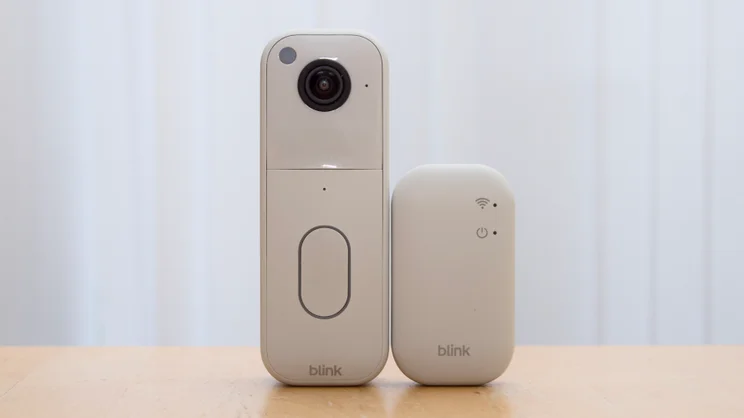
- Head-to-toe field of view
- Low cost, long battery life
- IP65 dust and water resistant
- Poor audio quality
- No local storage
Reviewed by Jonathan Bray
For those on the strictest of budgets, the second generation Blink Video Doorbell is the model to go for. As long as you stick to sales like Black Friday or Prime Day you’ll only be paying around £30 for the device and the Sync Core module, which is needed to connect the doorbell to your home Wi-Fi network. This makes it the cheapest video doorbell on the market.
It delivers decent quality 1,440p video, a broad 150-degree field of view, both vertically and horizontally, it’s super easy to set up and use, plus it blends perfectly with your existing Alexa-driven smart home setup, seamlessly integrating with Echo and Echo Show smart speakers. You can even plumb it into your existing doorbell wiring and keep it powered that way, something the old Blink doorbell couldn’t do.
There are drawbacks, though. The first is that, unless you already own a Sync Module 2, or you’re willing to pay an extra £40 for one, you’ll be paying a monthly subscription to store recorded video clips; it can’t store video locally on its own. The second is that audio quality remains unimpressive. When our reviewer tested it on his front door, it captured lots of distracting background noise.
All in all, the Blink Video Doorbell is an impressively low cost option, just note the weaknesses detailed above before committing your cash.
Read our full Blink Video Doorbell, 2nd gen (2025) review
Key specs – Camera: 1440p (1,440 x 1,440) with two-way audio; Field of view: 150-degrees (horizontal and vertical); Subscription required: Yes; Warranty: 2 years
5. Doro Hemma: Best simple video doorbell for the elderly and vulnerable
Price when reviewed: £150 | Check price at Amazon

- Simple and easy to use
- Comes with a chime in the box
- Doesn’t require a subscription
- Slow to react to motion
- Doesn’t support Alexa, HomeKit or Google Home
Reviewed by Alun Taylor
A video doorbell is a great way for vulnerable residents to screen visitors, and – if you’re a carer – for you to keep an eye out remotely, too. But technology can be confusing, especially for the elderly or infirm – and that’s an issue the Doro Hemma is aimed squarely at addressing.
It works like any other video doorbell, but it’s simpler to use and adds features not found on other doorbells, such as a piercing 97dB siren and the ability for users to hand off callers to relatives or carers if they’re feeling pressured or scared. It also comes with a loud 92dB chime in the box, and you don’t have to pay any ongoing subscription to access the doorbell’s key features, because it can store motion-triggered video on a microSD card.
And it compares well with normal video doorbells on performance, too. When we tested it, we found image quality was nice and sharp from the 1,440 x 1,440 resolution camera, and wide, too, with a 150-degree field of view. Although it wasn’t the speediest doorbell to react to motion, its reaction time to doorbell presses was very quick indeed.
Combined with a reasonable price of £150, we think it’s well worth considering over a Ring doorbell, or any other for that matter – if you fit the target demographic, that is.
Read our full Doro Hemma (2024) review
Key specs – Camera: 1,440 x 1,440 video with two-way audio; Field of view: 150-degrees; Local storage: Yes (via microSD card); Warranty: 12 months
6. Nest Doorbell (battery): Best Google Nest video doorbell
Price when reviewed: £180 | Check price at Amazon

- Battery or wired installation
- Some free video clip history
- Most features are unlocked and free
- Doesn’t come with a chime
- Facial recognition is subscription-only
Reviewed by Jonathan Bray
If you like the idea of the Nest Hello and its facial recognition but don’t want to wire it up to the mains, Google now has an alternative for you: the Nest Doorbell (battery). It’s much easier to install because you don’t have to connect it to the mains, and its battery that will last up to two and a half months before needing to be charged.
As with all of Google’s security products, image and audio quality is excellent, plus it’s stuffed with features, including AI-based facial recognition, and animal, vehicle and package detection. You don’t have to pay for a subscription to access most of the features and you even get some cloud video clip storage for free, although, the free video clip storage only stretches three hours into the past so it isn’t all that useful.
As with most video doorbells, you have to pay a subscription (starting at £5/mth) to unlock all the Nest Doorbell’s features, which puts it at a disadvantage to Eufy’s offering. However, given that this includes support for as many Nest security cameras as you own, and enables Google’s natty facial recognition feature, it’s actually pretty good value for those investing in it as part of a wider home security system.
Read our full Nest Doorbell (2022) review
Key specs – Camera: 960 x 1,280 resolution; Field of view: 145-degrees; Subscription required: No, but recommended (from £5/mth); Warranty: 2 year limited warranty
7. Ring Battery Video Doorbell (2024): Best budget Ring doorbell
Price when reviewed: £99 | Check price at Amazon

- Sharp, wide-angle 1,440 x 1,440 video
- Very easy to to set up
- Quick and responsive
- No option for local storage
- Paid subscription is required
Reviewed by Alun Taylor
Ring’s mid-price doorbell is an enticing buy for those who have already bought into the Ring Home security ecosystem. It’s incredibly good value at £100 (and it’s even cheaper during sales periods), plus it comes with features that had, previously, been restricted to Ring’s premium-level doorbells.
Its camera has a head-to-toe field of view, which lets you see whether a package has been left on your step. It comes with colour night vision, two-way talk and it’s much easier to remove and recharge the battery, too, thanks to a new quick-release system that doesn’t rely on the fiddly security screw system of old.
Performance is fast and responsive, but as ever with Ring doorbells, there are a couple of caveats. First, you need to be aware that they aren’t supplied with a chime in the box. When someone presses the doorbell button, it will ring the app on your phone, but others without the app installed on their phones won’t necessarily be able to hear it when someone is at the door. You have to pay extra for the Chime or Chime Pro unit if you want that essential “feature”.
It’s also worth being aware that you have to pay a monthly subscription to access your recorded video clips and other “advanced” features. If that doesn’t bother you, though, and all you want is a phone-based intercom system, this is a great value way to add a smart doorbell to your system.
Read our full Ring Battery Video Doorbell (2024) review
Key specs – Camera: 1,440 x 1,440 video with two-way audio; Field of view: 150-degrees; Local storage: No; Warranty: 12 months
8. Ring Video Doorbell Plus: Best Ring video doorbell
Price when reviewed: £130 | Check price at Amazon

- Broad vertical field of view
- Easy setup
- Delivers notifications quickly
- Requires a monthly subscription
- No chime included in the box
Reviewed by Jonathan Bray
With its iconic illuminated bell pushes, Ring’s line of video doorbells has become a suburban staple and the Ring Video Doorbell Plus is the firm’s best bang-per-buck doorbell yet.
It’s easy to install and can be run off battery or mains power, it has a sharper 1,536p camera than Ring’s previous offerings and – at long last – it comes with package detection, that can alert you whenever a delivery driver has left a box on your doorstep. Its best feature, however, is its 150-degree “head-to-toe” field of view, which allows you to see every inch of your visitors, down to the shoes they’re wearing. This also helps you where packages have been left, even if they’re fairly close to the door.
The Doorbell Plus misses out on video pre-roll and only operates over 2.4GHz Wi-Fi but those aren’t deal breakers and, in most other aspects, it performs brilliantly. Image quality is good, notifications are delivered in a speedy manner and it’s very easy to install and operate. As usual with Ring doorbells, the only major problem is that you have to pay the subscription (from £4.99/mth) if you want to use all the features. However, if you’re sold on the Ring way of doing things, this is its best doorbell yet.
Read our full Ring Video Doorbell Plus (2023) review
Key specs – Camera: 1,536p; Field of view: 150-degrees (horizontal and vertical); Installation: Battery/wired; Dual-Band Internet: No
9. Aqara Video Doorbell G4: Best video doorbell for iPhone owners
Price when reviewed: £120 | Check price at Amazon

- Supports Apple HomeKit Secure Video
- Some free cloud video clip storage
- Local storage and 24/7 recording
- No head-to-toe video
The Aqara G4 is the cheapest video doorbell to support Apple’s HomeKit platform we’ve reviewed so far. It also includes HomeKit Secure Video support, which means you can record detected clips in your iCloud storage instead of Aqara’s. At £120, however, it’s not just great for iPhone owners, it’s also packed with features that make it a great video doorbell for any user.
It comes with a chime in the box, which not all doorbells do, and the best thing about it is that Aqara provides seven days of rolling cloud storage for free. Plus, if you wire up the doorbell to the mains you can have it record video 24/7. It’s normally powered by six AA batteries, which last a claimed four months of use.
It doesn’t have head-to-toe video, which means you won’t be able to see if the Amazon driver has left a parcel on your step and its local face recognition system is flakey. However, video and audio quality are both decent, and we found that, in our testing, notifications came through very quickly indeed – around two seconds for the alert to sound on our phone over Wi-Fi or 5G. It’s a great doorbell at a great price.
Read our full Aqara Video Doorbell G4 (2024) review
Key specs – Camera: 1,920 x 1,080 resolution; Field of view: 162-degrees; Subscription required: No
How to choose the best video doorbell for you
What should I look out for in a video doorbell?
Your first consideration is how the video doorbell is connected, which really comes down to two options:
Battery-powered: Battery-powered doorbells get their charge from a rechargeable battery, meaning you don’t need any wiring in place; just a working Wi-Fi signal. While this has obvious benefits, it makes the unit bulkier and the battery will need charging. Luckily, you don’t have to do this too often. They last anywhere from two months to a year.
Wired: This means the doorbell must be connected to the wiring for your existing doorbell. This saves the hassle of changing batteries and the doorbell is usually more discreet. However, if you don’t have existing wiring, you may need to fork out for professional installation.
Performance
The time it takes a video doorbell to send a notification to your phone varies from model to model and is an important factor to consider when buying a doorbell, especially with delivery drivers on such tight deadlines these days.
Some doorbells can take ten seconds or longer to send through a notification to your phone, so by the time you’ve hit the answer button, or got up from your seat to go to the door, your visitor may have left already. Others pass notifications through almost instantaneously.
This is why we test for performance and general responsiveness. The chart below shows average response times for four different metrics – time from ring to notification on phone, time to launch live view from alert, time to launch live stream from app and time from motion detection to alert on phone – to give you a clear idea of how the best doorbells we’ve reviewed compare.
Note that we’ve only introduced this testing fairly recently, so we haven’t been able to include every doorbell we’ve ever reviewed in this chart. Also, the above chart only shows average times over a local Wi-Fi network as that’s the most reliable way for us to take a measurement. We do, however, test over a cellular connection, just to ensure there are no problems with remote connectivity, We do this by disconnecting the phone from Wi-Fi, connecting to it via 5G and by running all the tests again. This is usually slower but only by a second or two.
What’s more important: resolution or field of view?
Both are critical factors in deciding which doorbell to buy, but we would say that the field of view is marginally the more important. Measured in degrees, this dictates the width and height of the view your video doorbell can see.
Generally, the closer this figure gets you to 180-degrees, the better but typically, a good video doorbell will offer at least a 150-degree field of view both horizontally and vertically. A 150-degree vertical field of view, for instance, gets you a near head-to-toe view of your visitors.
Resolution is important because it helps you make out facial features more clearly and the finer details of packages left on your doorstep. In general, you want your doorbell to record in the highest resolution possible, but be aware that because of bandwidth restrictions and the small size of doorbell camera sensors, the difference between 1080p and 4K won’t be as big as you might expect.
It’s also worth noting that the higher the resolution, the more power hungry your doorbell is likely to be and (assuming you have a battery powered model) you’ll need to charge it more frequently.
Why does local storage matter?
Most video doorbells have the facility to store motion-triggered video clips remotely in the cloud. This is a great idea and very convenient, as it keeps your videos and devices separate: you can’t lose your clips if the doorbell is stolen, and remote access is quickly and easy.
This does, however, usually come at a price. Ring will charge you from £4.99 per month for the service, adding to the overall cost of the device and its doorbells can’t store recorded clips to local storage, effectively tying you into a monthly contract for the life of the product.
This is why it’s important to check that your doorbell can store video files in local storage: our favourite doorbells offer this facility and they work just as well as those that don’t.
Do I need a chime unit?
Call us old-fashioned but we think it’s important to be able to hear the doorbell chime across the house when visitors press the button. To hear the doorbell ring in the house (not just on your smartphone), you may well need a chime unit, but it’s not your only choice:
- Separate, wireless chime units are the simplest, most effective way to in our opinion. These (normally) plug into a mains socket, and you can often add more than one unit so you can hear the doorbell throughout your house. Not every doorbell comes with one in the box, though, so you may need to pay extra
- Smart speakers and screens such as the Echo Show, Echo Dot or Sonos Move can double up as chimes, too, but check that your doorbell is compatible first and be aware that setup can be complicated
- Wired doorbells can usually be connected to a traditional mechanical chime box – this is often the loudest, most reliable method – but do check the specifications carefully. Some wired doorbells will only take power and won’t send chime signal via existing wiring
Does it matter if I have Alexa or Google Home?
It most certainly does. If you want your doorbell to be part of a bigger home security system (for example, if you want it to work with a smart lock or wider security system) it pays to ensure that your doorbell works within the smart home ecosystem you’ve already chosen.
On a simpler level, it’s worth remembering that the two main players in the world of video doorbells – Nest and Ring – are owned by Google and Amazon respectively. That means that they tie in with the smart displays of both companies: Ring works brilliantly with Echo Show speakers, while Nest Hello plays nicely with the Nest Hub and Nest Hub Max. Technically, there’s a Nest skill for Alexa (but not a matching one of Ring for Google Home) but if you want maximum compatibility and support, it makes sense to ensure your systems match.
This doesn’t mean your doorbell has to be from the same manufacturer to be compatible, but integration and interoperability may not be as smooth and seamless.
What smart features are actually useful?
Manufacturers happily pepper their marketing with talk of smart this and smart that but beyond the basic functions – video intercom, motion-triggered video recordings – many aren’t essential.
The most useful, in our opinion, is facial recognition. You can use doorbells with this facility to quickly scan through your events to see what time, for example, your children came home or if they left for school on time. Or you can use it to alert you only when strangers approach your door. Other smart filters – pets, vehicles and packages – are a novelty and aren’t worth spending extra for.
Otherwise, the most important smart features are the ability to work with the main smart home ecosystems: Alex and Google Home. Devices supporting Apple’s HomeKit are less common but are also worth looking out for if you own an iPhone.
Support for these systems unlock various capabilities, from announcing visitors through smart speakers to smart home automations such as turning on internal and external smart lights when someone walks up to the door.
How much do I need to spend?
Video doorbells start at around £50 (sometimes less during Black Friday and Prime Day sales events) and the prices can go up above £200 for the most advanced models.
Don’t assume it’s always best to pay top whack, though, as even the cheapest video doorbell will do a job. Indeed, our favourite model costs a smidge over £100 and does everything you need a doorbell to do.











